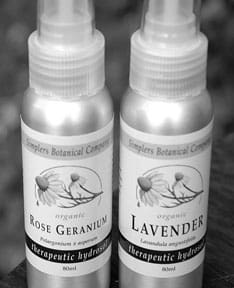NATURAL REMEDIES FOR CLEANING DOG WOUNDS: OVERVIEW
1. Clean cuts, abrasions, or wounds with skin-soothing herbal teas or an herb-vinegar rinse.
2. Spray or apply skin-healing hydrosols, essential oil blends, salves, or other topical products that stimulate cell growth, fight infection, and speed repair.
3. Give your dog enzymes and other supplements that help heal wounds from the inside.
4. Keep natural first-aid products on hand to treat bites, cuts, scrapes, and other wounds as soon as they occur.
Your dog just had surgery, stepped on broken glass, caught her tail in a door, has a puncture wound, got bit or scratched, tangled with barbed wire, or has an abrasion that came from who knows where. You want the wound to heal quickly without bleeding, pain, or infection. The following strategies help with cleaning dog wounds.
Topical Remedies for Cleaning Dog Wounds

Herbal Tea Rinses
Any wound can be cleaned and encouraged to mend with a strongly brewed herbal tea, which can be applied as a spray, rinse, wash, or compress.
Herbs known for their skin-healing properties include comfrey (Symphytum officinale) leaf and root, St. John’s wort (Hypericum perforatum) blossoms, calendula (Calendula officinalis) blossoms, broad- or narrow-leaved plantain (Plantago spp.) leaves, and lavender (Lavandula angustifolia) leaves and blossoms. Most herbal supply companies and natural foods markets sell dried herbs that can be used for wound treatment, or you can plant your own. Comfrey and lavender are easy-to-grow perennials, calendula is a self-seeding annual, and plantain and St. John’s wort grow wild in much of the U.S.
Comfrey is important to wound-healing because it contains allantoin, a cell growth stimulant. The plant used to be called “knit bone” because it helps heal broken bones when applied topically. Comfrey works so quickly that it should not be applied to sutures that will have to be removed or to puncture wounds in which bacteria might be trapped by rapidly healing skin, but it is highly effective on scrapes, burns, cuts, insect or spider bites, and other injuries.
Teas containing soothing anti-inflammatory herbs like German chamomile (Matricaria recutita), Roman chamomile (Anthemis nobilis), or lavender help reduce itching and discomfort when sprayed or applied topically.
To brew an herbal tea for wound cleansing or treatment, use 2 teaspoons dried herb or 2 tablespoons fresh herb per cup of boiling water. Cover and let the tea steep until cool. Strain, refrigerate, and apply as needed, up to several times per day.
Vinegar Rinse
Apple cider vinegar has long been used for first aid. Applied to cuts, wounds, dull fur, skin infections, calluses, and itchy areas, vinegar soothes skin, improves the coat, aids healing, and helps repel fleas and ticks.
For an old-fashioned skin tonic, try this simple blend of herbs in vinegar. Combine fresh or dried rosemary leaves, calendula blossoms, rose petals, juniper berries, lavender stalks or flowers, lemon peel, orange peel, sage, cinnamon, cloves, and/or chamomile blossoms, in any combination. Arrange herbs loosely in a glass jar (fill only one-third full with dried herbs) and cover with raw (unpasteurized) organic cider vinegar. Seal tightly and leave the jar in a warm place, in or out of the sun, for a month or longer.
Strain, transfer to storage bottles, and keep in a cool, dark place. Shake well before using to improve coat condition, rinse wounds, heal sores, repel insects, and soothe irritated skin. For dogs with white or very light coats, substitute plain white vinegar.
Willard Water
Willard water concentrate can be added to water, herbal tea, or hydrosols at the rate of 1 teaspoon per quart to help the liquid penetrate and speed the healing of burns, cuts, wounds, and other injuries.
Unrefined Sea Salt
Mineral-rich unrefined sea salt can be added to any tea that will be used to treat wounds.
Lightly salted and strained chamomile tea makes an excellent eye wash. Add 1/8 teaspoon salt per cup of tea.
To make an effective spray for any skin disorder, cut, or wound, combine 4 cups of any herbal tea, such as those described above, with ¾ cup aloe vera juice or gel and ½ cup unrefined sea salt.
Even plain salt water is a wound-healing treatment. Years ago in my dog’s obedience class, a female German Shepherd Dog suffered from a sore that wouldn’t heal despite repeated trips to the veterinarian over several months. When her owner applied a solution of 2 tablespoons unrefined sea salt in ½ cup water, the sore improved the same day and healed within a week.
Aromatherapy
Hydrosols are the “flower waters” produced along with essential oils during steam distillation. Hydrosols contain trace amounts of essential oil as well as all of the distilled plant’s water-soluble components. As a result, hydrosols are like a strong herbal tea combined with very dilute essential oils, making them safe for topical application even on young puppies and weak or elderly dogs.
Hydrosols are less expensive than essential oils, but they have a shorter shelf life. For best results, buy hydrosols from a reliable distributor and keep them refrigerated.
Leading hydrosols for wound care include the previously mentioned lavender plus helichrysum, also known as immortelle or everlasting (Helichrysum italicum); tea tree (Melaleuca alternifolia); oregano (Origanum vulgaris); and witch hazel (Hamamelis virginiana).
Essential oils have significant healing properties, but most essential oils – even those of the highest therapeutic quality – are so concentrated that they can overwhelm a dog’s sensitive olfactory system, causing discomfort, or have a harsh effect on the wound itself. Because they’re so powerful, essential oils can be greatly diluted without losing their effectiveness. Kristen Leigh Bell, author of Holistic Aromatherapy for Animals, recommends approximately 10 drops of essential oil per tablespoon of base oil for canine use. Diluting threapeutic-quality essential oils makes them both gentler and more affordable.
Ten drops of essential oil, such as those from plants listed above, in a tablespoon of base oil is an effective blend for cuts, wounds, scrapes, irritations, burns, bruises, and post-operative incisions.

An even more effective combination would be to use calophyllum or tamanu oil (Calophyllum inophyllum), which is pressed from the fruit and seed of the tamanu tree of India and Polynesia, as the base oil. Calophyllum oil is one of the most prized oils for healing wounds, burns, rashes, insect bites, broken capillaries, skin cracks, eczema, psoriasis, and other skin conditions. This oil can be used full-strength or diluted with equal parts jojoba, olive oil, or other base oil.
Any herbal oil can be turned into a salve by adding beeswax or other thickeners, as described in “Healing Oils For Your Dog“.
Coconut Oil
Coconut oil’s medium-chain fatty acids fight harmful bacteria, viruses, yeasts, fungi, and parasites, making it a perfect salve or dressing for cuts and wounds of every description. The only down side to coconut oil is that in temperatures below 75oF, it’s solid. Keep some in a small jar or bottle for easy warming in hot water.
Coconut oil is an excellent carrier oil for essential oils. But there is another down side – most dogs love the flavor and will quickly lick it off. If the wound is where your dog can’t reach, keeping it moist with coconut oil is an excellent idea.
EMT Gel
Many products are sometimes marketed as a first-aid kit in a tube, jar, or bottle, but EMT Gel truly is. Its key ingredient, collagen, is a fibrous protein found in connective tissue, muscles, ligaments, skin, bone, and cartilage.
EMT Gel’s specially processed bovine collagen acts as a tissue adhesive, providing a matrix for new cell growth while sealing and protecting wounds and significantly reducing pain, bleeding, scarring, wound weeping, and the risk of infection.
One of EMT Gel’s success stories comes from Shannon Rogers-Peisert of Liberty, Missouri, whose black Labrador Retriever, Cody, severed an artery while jumping a fence. “There was blood everywhere,” she says. “I had a sample of EMT Gel and thought to use it before taking Cody to the emergency clinic. The vet said it kept Cody from bleeding to death.”
In New Mexico in 2002, Troy Sparks and a friend spent quail season’s opening day hunting with Lucy, his Llewellyn Setter. When they returned to the truck, he noticed a blood clot on Lucy’s neck, and as he began to clean it, blood poured down her neck. Sparks applied EMT Gel, gauze, and vet wrap to hold it in place, then drove straight to Lucy’s veterinarian two hours away. When the vet removed the dressing, Sparks says, a six-inch stream of blood shot out. After getting stitches, Lucy recovered quickly.
Once applied, EMT Gel can be left undisturbed, which simplifies dressing changes. The collagen forms a plug that stops bleeding by encouraging clotting, and its occlusion of nerve endings reduces pain. Veterinarians in research universities and clinical practice recommend EMT Gel for abrasions, lacerations, skin ulcers, gunshot wounds, bites, first- and second-degree burns, electrical injuries, frostbite, post-surgical incisions, suture and IV sites, skin graft sites, and other wounds.
Sample sizes are no longer available. EMT Gel is sold in 1-ounce tubes and has a two-year shelf life.
The company also makes an EMT Gel Spray for the treatment of scrapes, scratches, and other minor skin injuries. In addition to wound-healing collagen, the nontoxic spray contains an extremely bitter taste that deters dogs from licking it off.
Tree resin, Pitch, and PAV Ointment
Tree resin or pitch contains powerful antibacterial, antiviral, and antifungal ingredients. In fact, pitch from America’s coniferous trees has been a folk remedy for centuries to treat skin infections, black widow and brown recluse spider bites, flea and tick bites, wasp and bee stings, gum infections, poison oak and ivy rashes, ringworm, staph infections, burns, scalds, surgical incisions, and other injuries.
The medicinal use of pitch had all but died out when it was resurrected in the 1970s by Forrest Smith, a retired logger from Northern California. Now his NATR (North American Tree Resin) company is the leading source of resin from the pitch of Pacific coast Douglas fir, yellow pine, and other coniferous trees.
Smith became interested in the healing properties of pitch when a medical missionary took some to South America. The physician spent years in remote areas, where he routinely performed surgery without sterile equipment or antibiotics. Before closing every incision, he covered the area with pitch and applied more before bandaging the wound. He was a steady customer for over 15 years because none of his patients developed an infection and all experienced rapid healing.
Smith recounts a friend’s experience years ago when he tried to help a dog that had been hit by a car. The dog was everyone’s friend, so the man did his best to patch him up even though his entrails were covered with sand as he lay by the side of the road. “My friend had some pitch with him,” says Smith, “and he poured it over the sandy intestines and shoved them back into the abdominal cavity. Then he covered the wound with more pitch and tied the dog together, no stitches, with rags wrapped around his body. That dog healed completely and lived in good health for several more years.”
More recently, a customer called to say that when her small dog was bit on the foot by a copperhead snake, the foot swelled quickly. “Not knowing what to do,” she said, “I found your resin bottle and covered the dog’s foot with it and wrapped it up. Soon he quit complaining and the next day he was running around as if nothing was wrong.”
Smith does not prescribe tree resin for snake bites or any other medical condition, but pitch has a long record of use for venomous bites and stings.
Pitch can be used full-strength or added to herbal salves and oils in any proportion. Mixing pitch with olive oil or another carrier helps it spread and reduces its stickiness. NATR’s products include full-strength pitch, pitch diluted with olive oil, a Hot Spot Pet/Livestock formula, and the company’s most popular product, PAV salve, which stands for Pitch and Vaseline petroleum jelly. All are safe for pet use. Avoid eyes and mucous membranes, and keep flammable pitch away from fire or flame.
Internal Supplements to Accelerate Your Dog’s Healing Process
Several vitamins and minerals are known to have healing properties, but zinc is especially important for wound healing. Supplementing the diet with a product like Standard Process Dermal Support, which contains zinc and other skin-healing ingredients from whole-food sources, provides the body with easily assimilated nutrients that help repair damaged tissue.
Zinc and other trace minerals are found in unrefined sea salt. Salt’s electrolytes and the enzymes they help produce are important to healthy immune function, rapid wound healing, adrenal health, and the regulation of bodily fluids. Add up to 1/8 teaspoon unrefined sea salt per 25 pounds of body weight per day to food.
Seacure
High-quality protein is essential for wound healing and for the repair of damaged fur and skin. Seacure, a deep-sea fermented whitefish powder, is predigested so that its amino acids and peptides, the building blocks of skin and hair, are immediately absorbed and utilized. The product is available in chewable dog-treat tabs and as a powder as well as in 500-mg capsules.
To help dogs recover from surgery, cuts, wounds, broken bones, or other trauma injuries, give at least twice the label’s recommended maintenance dose of 1 capsule, 1 tablet, or ¼ teaspoon powder per 10 pounds of body weight.
“There is no maximum dose,” says Dee Eckert, the manufacturer’s director of operations. “Several years ago my Basset Hound, Fergison, was attacked by another dog and suffered a severe puncture wound to his snout. I immediately took him to the vet, who said he would have a scar and that the hair on his nose would never grow back. Since he is allergic to many medications, surgery was not an option.
“After the vet thoroughly cleaned the wound, I took him home and gave him 3 tablespoons of Seacure daily. Within 48 hours, the wound closed and scabbed over. By the following week, it had completely healed and the hair was growing back. Fergison’s case was not unusual, for many pet owners, breeders, and vets have sent reports about how quickly wounds heal when Seacure for Pets is added to the animal’s diet.”
Colostrum Supplements
Colostrum, the “first milk” produced by mammals after giving birth, has become a popular supplement because of its immune-boosting properties. Some holistic vets, like Stephen Blake, DVM, of San Diego, feed colostrum to injured animals and also apply it to their cuts and wounds.
“I have found colostrum to be the best topical agent for healing any possible wound,” he says. “It works twice as fast as any other products I have used in the past 33 years. Colostrum contains EgF (epithelial growth factors) and IgF (insulin-like growth factor). Without adequate growth factors, the body cannot repair damaged cells, no matter how well the patient is being fed.”
Because research has shown that salivary amylase and hydrochloric acid in the stomach improve the activity of colostrum’s growth factors, Dr. Blake recommends offering the powder by itself on an empty stomach half an hour or more before a meal. “I give it once per day, first thing in the morning,” he says. “I haven’t yet met a dog who doesn’t like it that way, but if one exists, I would add it to food.”
To help injured dogs heal quickly, Dr. Blake recommends giving twice to three times the recommended maintenance dose of one 500-mg capsule or 1/3 teaspoon powder per 25 pounds of body weight per day. For an injured 50-pound dog, this would be 4 to 6 capsules or between 1 and 2 teaspoons powder per day.
For topical application, Dr. Blake mixes colostrum powder with enough water, herbal tea, or hydrosol to create a thin paste, which can be applied directly to wounds. “Your dog will want to lick it off,” he warns, “so keep him busy for five minutes while it gets absorbed, then let him do what he likes. Leave the wound open to breathe and apply colostrum twice a day until healing is well under way.”
Wobenzym
Wobenzym is a German enzyme product that is taken between meals on an empty stomach. Just as it’s given to human accident victims and surgical patients in large doses to speed healing and prevent swelling, tenderness, and bruising, it can be given to dogs immediately after injury or surgery.
Corneal ulcers, bruises, cuts, trauma injuries, and surgical incisions respond quickly to Wobenzym, which prevents swelling, breaks down inflammation, and speeds healing. Most dogs respond well to 1 tablet per 10 pounds of body weight (up to a maximum of 5 tablets at a time) given every 1 or 2 hours until improvement is seen. That dose is continued for several days or as needed. Once recovery is under way, a typical maintenance dose is up to 5 tablets twice or three times per day. See the October article for detailed instructions.
Wobenzym thins the blood and is not recommended for dogs with bleeding or platelet disorders, and caregivers should watch for small blood spots on the gums, pale gums, bloodshot eyes, or any abnormal bleeding. Reduce or discontinue the product if these unusual side effects occur.
Arnica Tincture
An important first-aid item, arnica tincture is best known for its dramatic effect on bruises and trauma injuries – and for its “external use only” labels. European physicians have long prescribed arnica tea or tincture as a cardiac agent, but it is such a powerful heart stimulant that most American herbalists believe arnica should never be taken internally or used on open wounds.
By taking such a cautious approach, say some experts, users deprive themselves of arnica’s most important potential. In small doses, arnica can stop internal bleeding and stimulate healing, especially after trauma injuries. For emergency use, give 1 drop of arnica tincture directly on the tongue or diluted in water per 15 pounds of body weight two to four times daily.
This simple therapy saved the life of Rosie, a cat whose encounter with a taxi resulted in a broken sacrum and broken tail. Because they believed she would never urinate or defecate normally, Rosie’s vets recommended putting her to sleep. But after a week of taking Herb Pharm’s arnica extract twice per day, Rosie was eliminating normally and made a rapid recovery.
Ed Smith, the founder of Herb Pharm, told me that Rosie’s story is typical and that arnica treats injury-caused incontinence and other problems in people as well as pets. A highly regarded herbalist and researcher, Smith finds no justification for the warning labels on arnica products. In addition to its internal use, he recommends applying arnica tincture to bleeding wounds and other injuries to reduce swelling, pain, and bruising. The sooner it is used after injury, he says, the better it works.
Barefoot Outdoors
Mother Nature’s healing aids include unfiltered natural light, which all of us need for optimum health, and direct (barefoot) exposure to earth or grass. Insufficient natural light can disrupt endocrine function and slow healing. Most dogs seek natural light, just as they seek contact with the bare earth or grass.
According to San Diego health researcher Dale Teplitz, “Clinical research suggests that standing on the earth can decrease inflammation and increase circulation to accelerate healing in dogs and people. When we are wounded, the immune system springs into action sending scavengers to the site to break down damaged tissues for removal from the body. Earth contact provides an unlimited supply of free electrons to neutralize excess free radicals that cause inflammation.”
Freelance writer CJ Puotinen is the author of The Encyclopedia of Natural Pet Care and many other books.





